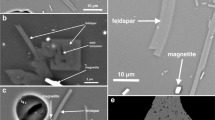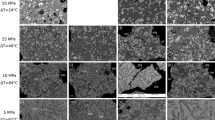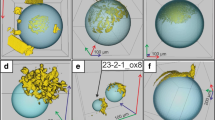Abstract
We performed decompression experiments to simulate the ascent of a phenocryst-bearing rhyolitic magma in a volcanic conduit. The starting materials were bubble-free rhyolites water-saturated at 200 MPa–800°C under oxidizing conditions: they contained 6.0 wt% dissolved H2O and a dense population of hematite crystals (8.7 ± 2 × 105 mm−3). Pressure was decreased from the saturation value to a final value ranging from 99 to 20 MPa, at constant temperature (800°C); the rate of decompression was either 1,000 or 27.8 kPa/s. In all experiments, we observed a single event of heterogeneous bubble nucleation beginning at a pressure P N equal to 63 ± 3 MPa in the 1,000 kPa/s series, and to 69 ± 1 MPa in the 27.8 kPa/s series. Below P N, the degree of water supersaturation in the liquid rapidly decreased to a few 0.1 wt%, the nucleation rate dropped, and the bubble number density (BND) stabilized to a value strongly sensitive to decompression rate: 80 mm−3 at 27.8 kPa/s vs. 5,900 mm−3 at 1,000 kPa/s. This behaviour is like the behavior formerly described in the case of homogeneous bubble nucleation in the rhyolite-H2O system and in numerical simulations of vesiculation in ascending magmas. Similar degrees of water supersaturation were measured at 27.8 and 1,000 kPa/s, implying that a faster decompression rate does not result in a larger departure from equilibrium. Our experimental results imply that BNDs in acid to intermediate magmas ascending in volcanic conduits will depend on both the decompression rate \( \left| {\left. {{\text{d}}P/{\text{d}}t} \right|} \right. \) and the number density of phenocrysts, especially the number density of magnetite microphenocrysts (1–100 mm−3), which is the only mineral species able to reduce significantly the degree of water supersaturation required for bubble nucleation. Very low BNDs (≈1 mm−3) are predicted in the case of effusive eruptions (\( \left| {\left. {{\text{d}}P/{\text{d}}t} \right|} \right. \) ≈ 0.1 kPa/s). High BNDs (up to 107 mm−3) and bimodal bubble size distributions are expected in the case of explosive eruptions: (1) a relatively small number density of bubbles (1–100 mm−3) will first nucleate in the lower part of the conduit (\( \left| {\left. {{\text{d}}P/{\text{d}}t} \right|} \right. \) ≈ 10 kPa/s), either at high pressure on magnetite or at lower pressure on quartz and feldspar (or by homogeneous nucleation in the liquid) and (2) then, extreme decompression rates near the fragmentation level (\( \left| {\left. {{\text{d}}P/{\text{d}}t} \right|} \right. \) ≈ 103 kPa/s) will trigger a major nucleation event leading to the multitude of small bubbles, typically a few micrometers to a few tens of micrometers in diameter, which characterizes most silicic pumices.








Similar content being viewed by others
References
Bagdassarov N, Dorfman A, Dingwell DB (2000) Effect of alkalis, phosphorus and water on the surface tension of haplogranite melt. Am Mineral 85:33–40
Bakker RJ (2003) Package FLUIDS 1. Computer programs for analysis of fluid inclusion data and for modelling bulk fluid properties. Chem Geol 194:3–23. doi:10.1016/S0009-2541(02)00268-1
Bindeman IN (2003) Crystal sizes in evolving silicic magma chambers. Geology 31:367–370. doi :10.1130/0091-7613(2003)031<0367:CSIESM>2.0.CO;2
Carmichael ISE (1967) The iron–titanium oxides of salic volcanic rocks and their associated ferromagnesian silicates. Contrib Mineral Petrol 14:36–64. doi:10.1007/BF00370985
Cashman KV (1988) Crystallization of Mount St. Helens 1980–1986 dacite: a quantitative textural approach. Bull Volcanol 50:194–209. doi:10.1007/BF01079682
Cashman KV, Mangan MT (1994) Physical aspects of magmatic degassing II. Constraints on vesiculation processes from textural studies of eruptive products. Rev Mineral 30:447–478
Catling DC, Moore JM (2003) The nature of coarse-grained crystalline hematite and its implications for the early environment of Mars. Icarus 165:277–300. doi:10.1016/S0019-1035(03)00173-8
Coombs ML, Gardner JE (2001) Shallow-storage conditions for the rhyolite of the 1912 eruption at Novarupta, Alaska. Geology 29:775–778. doi :10.1130/0091-7613(2001)029<0775:SSCFTR≥2.0.CO;2
Debenedetti PG (1996) Metastable liquids, concepts and principles. Princeton University Press, Princeton
Eustathopoulos N, Nicholas MG, Drevet B (1999) Wettability at high temperatures. Pergamon Materials Series, 3, Pergamon
Ferry JM, Baumgartner L (1987) Thermodynamic models of molecular fluids at the elevated pressures and temperatures of crustal metamorphism. Rev Mineral 17:323–365
Fletcher NH (1958) Size effect in heterogeneous nucleation. J Chem Phys 29:572–576. doi:10.1063/1.1744540
Formenti Y, Druitt TH (2003) Vesicle connectivity in pyroclasts and implications for the fluidisation of fountain-collapse pyroclastic flows, Montserrat (West Indies). Earth Planet Sci Lett 214:561–574. doi:10.1016/S0012-821X(03)00386-8
Gardner JE (2007) Heterogeneous bubble nucleation in highly viscous silicate melts during instantaneous decompression from high pressure. Chem Geol 236:1–12. doi:10.1016/j.chemgeo.2006.08.006
Gardner JE, Denis MH (2004) Heterogeneous bubble nucleation on Fe–Ti oxide crystals in high-silica rhyolitic melts. Geochim Cosmochim Acta 68:3587–3597. doi:10.1016/j.gca.2004.02.021
Gardner JE, Hilton M, Carroll MR (1999) Experimental constraints on degassing of magma: isothermal bubble growth during continuous decompression from high pressure. Earth Planet Sci Lett 168:201–218. doi:10.1016/S0012-821X(99)00051-5
Gualda GAR, Rivers M (2006) Quantitative 3D petrography using X-ray tomography: application to Bishop Tuff pumice clasts. J Volcanol Geotherm Res 154:48–62. doi:10.1016/j.jvolgeores.2005.09.019
Haar L, Gallagher JS, Kell GS (1984) NBS/NRC Steam Tables: thermodynamic and transport properties and computer programs for vapor and liquid states of water in SI units. Hemisphere Publishing Corporation, Washington
Higgins MD (2002) Closure in crystal size distributions (CSD), verification of CSD calculations, and the significance of CSD fans. Am Mineral 87:171–175
Hirth JP, Pound GM, St. Pierre GR (1970) Bubble nucleation. Metal Trans 1:939–945. doi:10.1007/BF02642816
Holtz F, Behrens H, Dingwell DB, Johannes W (1995) H2O solubility in haplogranitic melts: compositional, pressure, and temperature dependence. Am Mineral 80:94–108
Hurwitz S, Navon O (1994) Bubble nucleation in rhyolitic melts: experiments at high pressure, temperature and water content. Earth Planet Sci Lett 122:267–280. doi:10.1016/0012-821X(94)90001-9
Klug C, Cashman KV (1994) Vesiculation of May 18, 1980, Mount St. Helens magma. Geology 22:468–472. doi :10.1130/0091-7613(1994)022<0468:VOMMSH>2.3.CO;2
Klug C, Cashman KV, Bacon CR (2002) Structure and physical characteristics of pumice from the climactic eruption of Mount Mazama (Crater Lake), Oregon. Bull Volcanol 64:486–501. doi:10.1007/s00445-002-0230-5
Laporte D (1994) Wetting behavior of partial melts during crustal anatexis: the distribution of hydrous silicic melts in polycrystalline aggregates of quartz. Contrib Mineral Petrol 116:486–499. doi:10.1007/BF00310914
Mangan M, Sisson T (2000) Delayed, disequilibrium degassing in rhyolite magma: decompression experiments and implications for explosive volcanism. Earth Planet Sci Lett 183:441–455. doi:10.1016/S0012-821X(00)00299-5
Mangan M, Sisson T (2005) Evolution of melt-vapor surface tension in silicic volcanic systems: experiments with hydrous melts. J Geophys Res 110. doi:10.1029/2004JB003215
Martel C, Bureau H (2001) In situ high-pressure and high-temperature bubble growth in silicic melts. Earth Planet Sci Lett 191:115–127. doi:10.1016/S0012-821X(01)00407-1
Martel C, Schmidt BC (2003) Decompression experiments as an insight into ascent rates of silicic magmas. Contrib Mineral Petrol 144:397–415
Marziano GI, Schmidt BC, Dolfi D (2007) Equilibrium and disequilibrium degassing of phonolitic melt (Vesuvius AD 79 “white pumice”) simulated by decompression experiments. J Volcanol Geotherm Res 161:151–164. doi:10.1016/j.jvolgeores.2006.12.001
Massol H, Jaupart C (1999) The generation of gas overpressure in volcanic eruptions. Earth Planet Sci Lett 166:57–70. doi:10.1016/S0012-821X(98)00277-5
Massol H, Koyaguchi T (2005) The effect of magma flow on nucleation of gas bubbles in a volcanic conduit. J Volcanol Geotherm Res 143:69–88. doi:10.1016/j.jvolgeores.2004.09.011
Mourtada-Bonnefoi CC, Laporte D (1999) Experimental study of homogeneous bubble nucleation in rhyolitic magmas. Geophys Res Lett 26:3505–3508. doi:10.1029/1999GL008368
Mourtada-Bonnefoi CC, Laporte D (2002) Homogeneous bubble nucleation in rhyolitic magmas: an experimental study of the effect of H2O and CO2. J Geophys Res 107. doi:10.1029/2001JB000290
Mourtada-Bonnefoi CC, Laporte D (2004) Kinetics of bubble nucleation in a rhyolitic melt: an experimental study of the effect of ascent rate. Earth Planet Sci Lett 218:521–537. doi:10.1016/S0012-821X(03)00684-8
Naney MT (1983) Phase equilibria of rock-forming ferromagnesian silicates in granitic systems. Am J Sci 283:993–1033
Navon O, Lyakhovsky V (1998) Vesiculation processes in silicic magmas. In: Gilbert JS, Sparks RSJ (eds) The physics of explosive volcanic eruptions. Geol Soc London Spec Publ 145:27–50
Newman S, Stolper EM, Epstein S (1986) Measurement of water in rhyolitic glasses: calibration of an infrared spectroscopic technique. Am Mineral 71:1527–1541
Orsi G, Gallo G, Heiken G, Wohletz K, Yu E, Bonani G (1992) A comprehensive study of pumice formation and dispersal: the Cretaio tephra of Ischia (Italy). J Volcanol Geotherm Res 53:329–354. doi:10.1016/0377-0273(92)90090-Z
Proussevitch AA, Sahagian DL, Anderson AT (1993) Dynamics of diffusive bubble growth in magmas: isothermal case. J Geophys Res 98:22283–22307. doi:10.1029/93JB02027
Rutherford MJ, Gardner JE (2000) Rates of magma ascent. In: Sigurdsson H (ed) Encyclopedia of volcanoes. Academic Press, San Diego
Sparks RSJ (1978) The dynamics of bubble formation and growth in magmas: a review and analysis. J Volcanol Geotherm Res 3:1–37. doi:10.1016/0377-0273(78)90002-1
Sparks RSJ, Barclay J, Jaupart C, Mader HM, Phillips JC (1994) Physical aspects of magma degassing I. Experimental and theoretical constraints on vesiculation. Rev Mineral 30:413–445
Tamic N, Behrens H, Holtz F (2001) The solubility of H2O and CO2 in rhyolitic melts in equilibrium with a mixed CO2–H2O fluid phase. Chem Geol 174:333–347. doi:10.1016/S0009-2541(00)00324-7
Toramaru A (1990) Measurement of bubble size distributions in vesiculated rocks with implications for quantitative estimation of eruption processes. J Volcanol Geotherm Res 43:71–90. doi:10.1016/0377-0273(90)90045-H
Toramaru A (1995) Numerical study of nucleation and growth of bubbles in viscous magmas. J Geophys Res 100:1913–1931. doi:10.1029/94JB02775
Toramaru A (2006) BND (bubble number density) decompression rate meter for explosive volcanic eruptions. J Volcanol Geotherm Res 154:303–316. doi:10.1016/j.jvolgeores.2006.03.027
Whitham AG, Sparks RSJ (1986) Pumice. Bull Volcanol 48:209–223. doi:10.1007/BF01087675
Yamada K, Tanaka H, Nakazawa K, Emori H (2005) A new theory of bubble formation in magma. J Geophys Res 110. doi:10.1029/2004JB003113
Zhang Y (1999) H2O in rhyolitic glasses and melts: measurement, speciation, solubility, and diffusion. Rev Geophys 37:493–516. doi:10.1029/1999RG900012
Zhang Y, Behrens H (2000) H2O diffusion in rhyolitic melts and glasses. Chem Geol 169:243–262. doi:10.1016/S0009-2541(99)00231-4
Zhang Y, Sturtevant B, Stolper EM (1997) Dynamics of gas-driven eruptions: experimental simulations using CO2–H2O-polymer system. J Geophys Res 102:3077–3096. doi:10.1029/96JB03181
Acknowledgments
Our research program on bubble nucleation was supported by grants from the Institut National des Sciences de l’Univers (ACI “Dynamique éruptive des volcans antillais” 2004–2006) and from the Agence Nationale de la Recherche (ANR-EXPLANT, contract No. ANR-05-CATT-003 to C. Martel). It benefited from discussions with Hélène Massol, Morihisa Hamada, Tim Druitt, Thomas Giachetti, and Caroline Martel. We are grateful to Jean-Luc Devidal for technical assistance with the electron microprobe, Jean-Marc Hénot for assistance with the scanning electron microscope, and Nathalie Bolfan-Casanova and Ken Koga for assistance with the FTIR spectrometer.
Author information
Authors and Affiliations
Corresponding author
Additional information
Communicated by T.L. Grove.
Rights and permissions
About this article
Cite this article
Cluzel, N., Laporte, D., Provost, A. et al. Kinetics of heterogeneous bubble nucleation in rhyolitic melts: implications for the number density of bubbles in volcanic conduits and for pumice textures. Contrib Mineral Petrol 156, 745–763 (2008). https://doi.org/10.1007/s00410-008-0313-1
Received:
Accepted:
Published:
Issue Date:
DOI: https://doi.org/10.1007/s00410-008-0313-1




